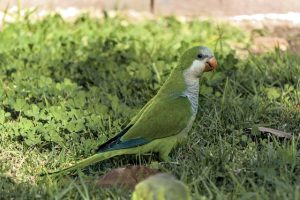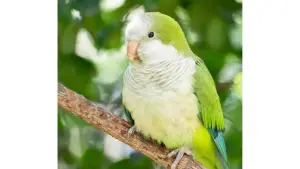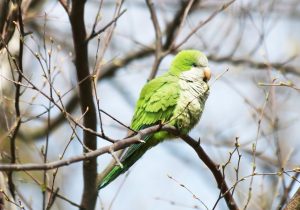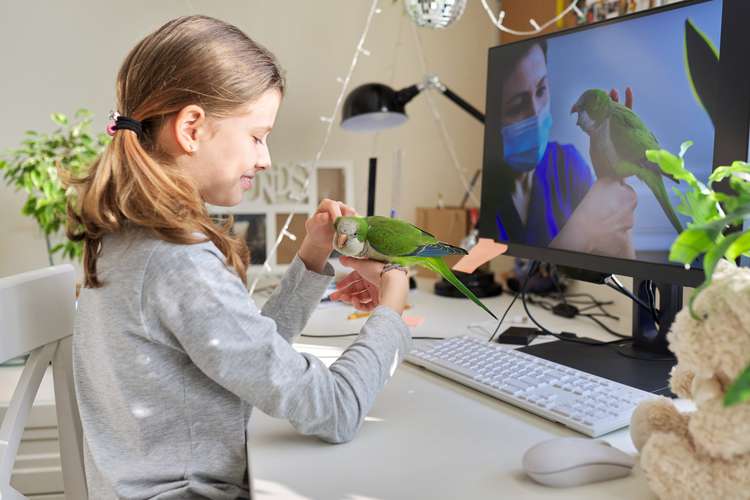If you want the excitement, love, affection, and comical attributes that any large parrots offer but in a more petite body due to inadequate space to house a large bird.
The Quaker parrot is an excellent bird to consider. However, it is essential to note the vital Quaker parrot facts before going ahead with a purchase or adoption plan.
This ensures you can meet the expectations and needs these birds to expect/demand of their owners/caregivers to live a comfortable lifestyle for enhanced growth and health.
10 Quaker Parrot Facts & Personality

01. Quaker Parrot Food List
While it is essential to feed Quaker parrots with enough food to ensure they don’t go hungry or get enough energy to stay active and survive. The feeding process should never go unmonitored.
In a situation where the owner or caregiver fails to monitor how these birds eat, especially the type of diets they feed on. It could lead to obesity.
Just as it is experienced in humans, birds such as the Quaker parrot can become unhealthily heavy if the owner pays less attention to their diets.
Some healthy diets that could be added to their food list include highly-nutritive pellet/parrot mix, high-quality cereals, meat (dried), and sweet potatoes.
Also, nuts, fruits, leafy greens, and vegetables are healthy options that should be integrated into their food.
These are considered special foods since they are diets they feed on in their natural habitat or wild.
Avoid an excessive supply of fattening seeds, millet, and nuts. These foods shouldn’t be offered in their diet freely/excessively to restrict fast and unhealthy weight gain.
02. Quaker Parrot Male vs Female: How To Identify Them?
Quaker parrots are monomorphic. Since these birds share the same physical qualities, irrespective of gender.
It is hard to differentiate between the female and male birds by relying merely on how they look.
Individuals interested in detecting the gender of their bird (to know if they have a male or female Quaker) must be prepared to settle for either surgical sexing procedure or DNA sexing as the case may be.
These two techniques are the only reliable means of finding out this exciting detail about the Quaker parrots or guarantee appropriate/proper identification.
Do not hesitate to discuss this topic with an experienced/proven avian veterinarian to discuss the steps involved.
03. Quaker Parrot Breeding Habits
While in the wild, parrots are usually known to live in tree hollows, holes built in the ground, abandoned structures, rocks, and other suitable places (safe enough and closer to their food source).
However, the Quaker parrot has a different habit or approach to where they live.
These birds build their nests by relying on materials such as twigs, sticks, and tree branches, making them the only parrot with such a behavior/attribute.
The nests are always extensive, having several rooms in them. They live together as a group or community, building their nests very close to one another.
Their nests serve several purposes, aside from providing adequate shelter and protection from extreme conditions.
These roomy/expansive nests are where the females lay and incubate their eggs.
Quaker parrots can lay between four (4) and twelve (12) eggs at a single time. The incubation period lasts between three and four weeks.
During winter, flocks of Quaker parrots that make South America their natural habitat, especially those who live very far away from the urban or suburban regions, move to where there is abundant food to cater to their wellbeing.
04. Quaker Parrot Legal States 2022
This section highlights the state where Quaker parrots are permitted to be kept as pets.
However, some states allow individuals interested in these birds to go ahead and bring them home without any restrictions.
Some other states have a different approach. There are rules/regulations in place that individuals interested in owning a Quaker parrot must follow to avoid sanctions.
The legal States Without Any Restrictions
- Alabama
- Utah
- Florida
- Washington
- Alaska
- South Dakota
- Arizona
- Texas
- Idaho
- Oregon
- Arkansas
- South Carolina
- Illinois
- Oklahoma
- Delaware
- South Dakota
- Maryland
- North Carolina
- Indiana
- North Dakota
- Iowa
- Missouri
- Nevada
- Michigan
- New Mexico
- Louisiana
- Minnesota
- Montana
- Massachusetts
- Nebraska
- Mississippi
The legal States With Restrictions

a) Ohio
The parrot must have its wings or feathers clipped to eliminate possible escape from the owner’s watch.
b) New York
The Quaker parrot must be appropriately tied down or locked inside the cage. Under no conditions must it be seen outdoor.
c) New Jersey
Before any individual can bring this bird home, the Fish and Wildlife Division requires the prospective owner to provide/present some official documents.
d) Virginia
The rule/restriction is similar to what’s acceptable in New York.
e) Vermont
Your parrot must have a means of identification that guarantees an easy connection/link to the breeder.
05. Quaker Parrot Illegal States
Some parts of the United States of America do not agree/align with the idea of keeping a Quaker parrot as a pet due to their invasive nature/attribute.
They destroy plants, crops, and other resources when allowed in a large number.
Also, Quaker parrots could pose a significant threat or unhealthy competition for other local animals such as sparrows and pigeons.
The prohibition/ban is a measure that ensures their populations are appropriately regulated or checked.
States, where these birds are prohibited include the following:
- Wyoming
- Colorado
- California
- Hawaii
- Rhode Island
- Pennsylvania
- Georgia
- Connecticut
- Kentucky
- Kansas
Suppose anyone owns a Quaker parrot and lives in any of the above-mentioned states. Ensure adequate measures are in place to restrict possible escape.
06. How To Train a Quaker Parrot Not To Bite
Naturally, Quaker parrots are entertaining and fun-loving. They require as much attention as possible from the owner/caregiver.
While these birds could have a smaller body or physical appearance, they desire similar treatment, care, and attention as the large parrots.
Quaker parrots are known to form a great companionship with their owners, pledging their loyalty. However, building/developing this connection takes time, patience, and commitment.
Owners must be ready to spare a few hours daily (3-4) to bond with their Quaker parrot. Cuddle them as much as possible and teach them some tricks and how to say a few words to enhance their mental capabilities.
The owner can rub their hands across the bird’s head whenever it gives an anticipated response or performs the desired action. They find it pleasurable.
When they do not get enough time and attention from the owner, a Quaker parrot becomes unhappy, fearful, and depressed. It may attempt to bite and destroy things around in such a situation.
07. How Big is a Quaker Parrot
Quaker parrots are small in size.
They are the perfect pet choice for individuals who love an intelligent bird that offers loyalty and great companionship but doesn’t have adequate space to accommodate/house a big-sized species or breed.
On average, an adult Quaker parrot can grow up to twelve (12) inches.
08. Quaker Parrot Weight
The weight of a healthy adult Quaker parrot (when supplied with healthy/nourishing diets and a closely monitored feeding habit) is between four (4) and five (5) ounces.
That is about 4.5 ounces, on average. If your bird weighs more than five (5) ounces.
It should never be entirely accepted as an interpretation or sign of excellent feeding. The bird may have to be checked and treated for obesity.
09. Quaker Parrot Mutations and Color Variations

Adult Quaker parrots are easily noticeable and distinguishable by their green (bright) color across body parts such as head, back, and feathers.
However, gray throat, breast, and cheeks are the most distinctive attribute. The blue flight wings are beautiful to behold.
Also, the green tint/shade (light) beneath the tail adds to its distinct attractiveness.
Over the years, there have been several color mutations via the numerous breeding programs targeted at creating various varieties of birds in captivity.
These programs gave rise to the multiple Quaker varieties/types we see today.
Sometimes in the 2020s (during the early phase), the blue hybrid Quaker parrot came into existence. It is the most popular Quaker parrot mutation up to date.
Other famous Quaker parrot mutations created by breeders include Lutino, Cinnamon, Pied, and Albino/White.
10. Quaker Parrot Body Language and Sounds
Quaker parrots possess a high level of intelligence that supersedes many other parrot breeds/species.
Their top-level intelligence reflects how fast they pick new words, phrases, or speeches their owners often use or say. Also, they can easily relate to new sounds or voices, memorizing them quickly.
The tone is clear enough to pick up their words whenever these birds speak.
To keep them energetic and in high spirits. The owner must ensure they enjoy an adequate level of socialization, have a series of toys to play with (for fun and entertainment), and learn new tricks that enhance their mental wellbeing.
By building a solid bond/companionship with a Quaker parrot, it reciprocates by showering extensive love, making the owner feel loved and appreciated.
It is easy to pick up the excitement in their tone while welcoming the owner back home.
These birds are not as noisy as other parrots. Although Quaker parrots love to talk, sing, or mimic sounds. They do not scream in such a way that could inconvenience people around.
Also, these birds are intentional about their space (territorial). For someone who could someday decide to bring in another Quaker parrot, the integration should be done appropriately.
Allow both birds to acquaint/familiarize themselves (placing their cages close to each other) before any direct contact is considered.
Quaker Parrot Fun Facts You Should Consider Before Adopting Them as Pets
01. Quaker parrots are small and are suitable for individuals who lack a large area or space to accommodate large birds.
Nevertheless, they need adequate space to stretch, move freely, play, and exercise. At least an eighteen (18) inches square cage should be considered.
02. They are not legal across all the states. Check if your state permits owning or adopting one before bringing them home.
03. They possess a strong beak capable of destroying or breaking a poorly constructed cage.
The cage’s construction material must be tough, ensuring it can’t be chewed, broken, or damaged with ease to prevent these birds from escaping.
This is especially important for intending owners living in any state with restrictions or rules that guide owning a Quaker parrot.
04. These birds love a wide range of food (check the section that discusses their foods/diets)
05. Naturally, they are builders. As we mentioned earlier, they are the only parrot species that build their nests from tree branches and sticks.
Someone willing to pick up a Quaker parrot as a pet should expect to see this attribute in play.
06. Both genders are indistinguishable, merely looking at the physical properties.
07. They form a community/group, building their nests close to one another in the wild.
08. Quaker parrots demand a lot of time and attention from their owners for companionship and mental stimulation.
09. Quaker Parrots have an admirable lifespan. On average, these birds can remain healthy for up to twenty-five (25) years, extending to thirty (30) years or more in some cases.
10. They possess a wide range of vocabulary. These birds learn several words with ease and communicate these phrases clearly & accurately.
How Good Are Quaker Parrot Personality as First Pet?
A Quaker parrot is an excellent pet choice for anyone who hasn’t owned a pet previously or before now.
Asides from their attractive appearance, they are very intelligent. Their level of intelligence is evident in how intentional they are about learning new words or phrases used around them.
Also, the level of adaptability in a new environment is impressive. Quaker parrots integrate excellently into the human setting without constituting any nuisance (do not make disturbing noise/sound).
Naturally, these birds are somewhat gentle. This attribute makes them an excellent pet choice for people with kids.
People Also Ask For
What are some interesting facts about quaker parrots?
Quaker parrots, also known as monk parakeets, are fascinating for their communal nesting habits, constructing large nests shared by multiple pairs. They’re notable for their vocal abilities, capable of mimicking speech and sounds. Originally from South America, they’ve established wild populations in various countries, showcasing their adaptability. Additionally, some regions consider them pests due to their nest-building behaviors around power lines.
Are Quaker parrots intelligent?
Yes, Quaker parrots are recognized for their intelligence. They display problem-solving skills, social interactions, and can even learn to mimic speech. Their ability to adapt to different environments and their communal nesting behavior also highlight their cognitive capabilities.
Are Quaker parrots friendly?
Quaker parrots are often considered friendly and social birds. They can form strong bonds with their human caretakers and engage in interactive behaviors. However, individual personalities vary, so while many Quaker parrots are friendly and affectionate, some might be more reserved or cautious. Proper socialization and positive interactions can contribute to their friendly nature.
Can Quaker parrots talk?
Yes, Quaker parrots have the capacity to talk. They are known for their ability to mimic human speech and various sounds. While their talking ability might not be as advanced as some larger parrot species, they can still learn and repeat words and phrases with proper training and socialization.
What do quakers eat?
Quaker parrots, also known as monk parakeets, have a varied diet that typically includes a mix of seeds, fruits, vegetables, nuts, and grains. Providing a balanced diet of fresh foods along with high-quality commercial bird pellets ensures they receive the necessary nutrients for their well-being.
Final Words
Do not bring a Quaker parrot home until relevant findings/studies have been conducted.
First, prospective owners must understand the rules/regulations regarding ownership (in legal states) and be satisfied with the terms.
Also, ensure you can afford the necessary needs/demands of these birds across their lifespan.
The owner must have the financial capabilities to ensure adequate feeding, housing, and health.
We hope the Quaker parrot facts we have highlighted will provide the relevant details that prospective owners and existing owners can rely on or find helpful as they attempt to give their birds the best care they deserve.
https://pethelpful.com/birds/Quaker-Parrots-Amazing-Pets

Hi, I’m Regina Rios. Just another bird lover who loves to share knowledge from personal experience. I’ve grown up with pet birds since childhood as my mommy also loves birds. As I can’t pet many birds in open air in my house as my mom does; I created my first bird cage on my rooftop using wood, copper wire, and a metal shed in 2018 and start collecting pet birds. Now, I have so many pet birds such as Macaws, Parrot, Cockatiel, Parakeet, and others. Not only that, if I see natural birds are injured I keep them in my house until they get well. Now, my hobby becomes my income source as my home birds have babies and I sell them to birds lover like mine. I’ve created this blog to inspire others bird owners by sharing my personal knowledge. Good Luck!


